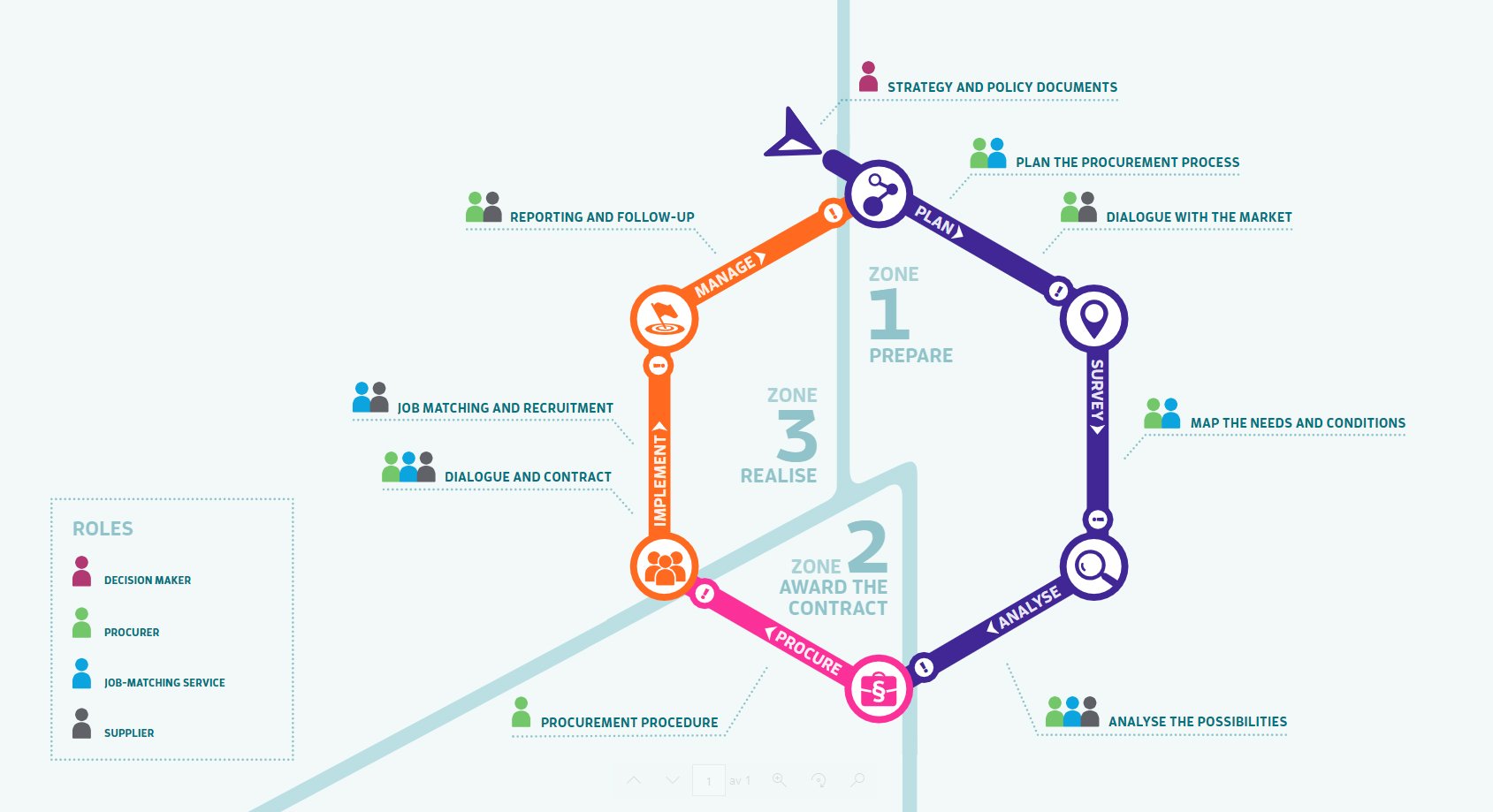Decision maker - employment requirements
Successful procurement for employment requirements involves several parties. To make it easy for you to get started quickly, we have collected the most important advice and tips in simple checklists.
Content
Employment requirements in public procurement means that a purchasing organisation places conditions in the procurement contract so that, for the contractual period, the successful bidder must provide employment, training, internship or traineeship for individuals who have difficulty entering the job market. Public procurement with employment requirements is one of several possible ways of helping people on the job market.

Success factors that have been identified in procurement with employment requirements:
- Clear decisions, political will and courage from management and decision makers.
- Active dialogue with suppliers and social partners.
- Close cooperation with the job-matching service.
- Resources allocated for procurement as well as the follow-up.
Analysing conditions
For your purchases to be successful in helping people on the job market, the situation must be analysed.
Questions to consider:
- What do we want to achieve with employment requirements in procurement?
- What will the job market be like in our area/region over the next five years?
- Are our suppliers experiencing a skills shortage?
- What is integration like in the job market?
- What skills do those who are unemployed have?
- Can employment requirements in procurement be used as one of several ways of helping people on the job market?
- Do we want to use bonus incentives to promote gender equality and/or increase employment? Have we budgeted for this?
- Could we consider collaborating with other contracting organisations?
Decision
Based on the analysis, it can be decided whether employment requirements in procurement are suitable for your organisation. When used correctly, they can be an effective tool for correcting social imbalance, increasing employment and improving skills supply for the companies.
Decision support document (SV)
Prepare steering and policy documents
You have now determined to set employment requirements and decided to make a difference! That means it is time to prepare steering documents for the organisation and ensure that you are able to carry out the operational work. First, consider whether you wish to start with a pilot procurement project or get started right away.
Start with a pilot project?
- It can sometimes be a good idea to start with a pilot project in a limited procurement area or for a limited time.
Ready to start right away?
- Develop policies and guidelines for the entire organisation. Steering and policy documents, for example, can describe applicable industries, target groups and/or the scope of procurement objects.
Prepare the organisation
It is important that the contracting organisation has the resources needed for effectively providing support to purchasers and suppliers before, during and after the procurement process.
To be well prepared, consider the following:
- It is good to have a dedicated person who is passionate about the issue who can be in the driving seat.
- Make sure the contracting organisation has the resources needed for following up the requirements set in the contract.
- Can the local authorities, the public employment service or anyone else train/equip people who are currently outside the job market?
- Can our suppliers help develop the skills of individuals?
- Do we have an organisation working with job market issues, or can we collaborate with the public employment service, private job-matching services or other social enterprises?
- Do we have any procurement objects where it would be appropriate to set employment requirements? Do we have any procurement objects where it could be inappropriate or that require special attention (unfair competition/unhealthy market)?
- Consult with various partners for example, trade unions and employer organisations in that sector and make sure that the employment requirement does not cause any displacement effects.
Communicate internally and externally
When you begin setting employment requirements in contracts, it needs to be communicated both internally and externally.
Who do we need to reach internally?
- Management groups
- Staff groups
- Project Managers/purchasers
- Job-matching services
Who do we need to reach externally?
- Suppliers
- The local business community
- Industry and employer's organisations
- Trade unions
Follow up the results
After a while, it is time to follow up the results and identify any deficiencies. See whether the steering and policy documents and/or guidelines need to be adjusted.
Some good questions to ask:
- How many procurements have included employment requirements?
- How many individuals have become employed?
- What do the suppliers say?
Can we see any difference in costs or in the number of tenders submitted? - Are resources sufficient to handle the operational work?
- Do we have the right functions and roles?
- Are procedures and collaborations in the process working?
- What are the success factors?
- What can be improved?
- Have we seen any socioeconomic gains?
Handling of personal data in connection with the follow-up
When following up employment requirements, it may be necessary to have access to personal data. The General Data Protection Regulation (GDPR—Regulation 2016/679/EU of the European Parliament and of the Council) applies to all processing of personal data.
